Yoga for Digestion
- By Rebecca Taggart
- Reading Time: 5 mins.
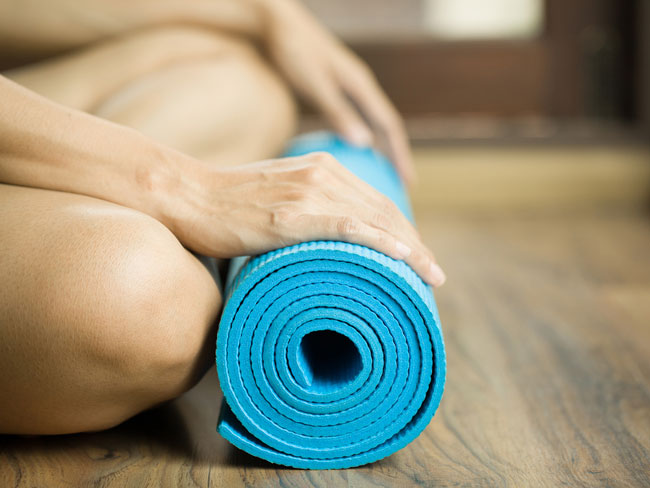 Nothing is more traditional than eating large festive meals, starting at Thanksgiving and continuing right on through New Year’s Eve. With the days getting colder and darker, we also tend to exercise less while eating more. Try the following restorative yoga poses to aid digestion after feasting, and to regain energy lost to tryptophan. You may find your most contented moments of the year in these three relaxing and heart-opening postures. Allow yourself to express gratitude for your body even as you voice thanks for everything good in your life. Happy holidays!
Nothing is more traditional than eating large festive meals, starting at Thanksgiving and continuing right on through New Year’s Eve. With the days getting colder and darker, we also tend to exercise less while eating more. Try the following restorative yoga poses to aid digestion after feasting, and to regain energy lost to tryptophan. You may find your most contented moments of the year in these three relaxing and heart-opening postures. Allow yourself to express gratitude for your body even as you voice thanks for everything good in your life. Happy holidays!
In restorative yoga, it is very important to use support, both under your back and for your head and arms where indicated. You can use couch or bedroom pillows or a stack of folded blankets if you don’t have a yoga bolster on hand. Use rolled towels or small blankets for head support. In all these poses, be sure to use your back support to emphasize the opening of the chest and abdominal areas. De-emphasize active stretching and relax into the supports.
1. Supta Baddha Konasana (reclined bound angle pose)
• Relieves indigestion and gas. Fine to do even directly after eating.
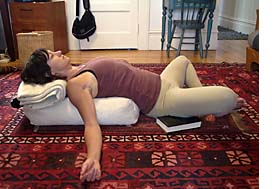
On a yoga mat or area rug, place support that is as long as your torso. Place a rolled towel at the far end to support your head. You will need two additional rolled towels or blankets to support your thighs. Sit on the front end of your support and bring the soles of your feet together, with your knees dropping out to either side. Slide forward off the support, keeping your heels as close to your groins as is comfortably possible. Without allowing your feet to slide farther away from your groin, place your palms beside you and slowly lie back onto the support. Place the folded blanket or towel under your head and neck. Under the top of your thighs, place the rolled towels (you can also use thick books or even soup cans) so that the position is comfortable when you lie back and your abdomen can soften.
Get tips for your office
Be an office hero!
 Draw your buttocks toward your heels to lengthen your back. Your lower back should feel soft and comfortable. If not, try sliding your buttocks farther away from the support so that only your middle and upper backrest on the support. Rest your arms on the floor at your sides, with your palms facing up toward the ceiling.
Draw your buttocks toward your heels to lengthen your back. Your lower back should feel soft and comfortable. If not, try sliding your buttocks farther away from the support so that only your middle and upper backrest on the support. Rest your arms on the floor at your sides, with your palms facing up toward the ceiling.
Once you are comfortable, stay in this pose for 5 to 10 minutes, allowing your breath to deepen naturally and your muscles to relax completely.
To come out of the pose, place your hands outside your thighs and use them to pull your knees up and together. After a few breaths, exhale and roll to the right-hand side, then use your hands to help you sit up.
2. Setu Bandha Sarvangasana (supported bridge pose)
• Revives energy and aids digestion
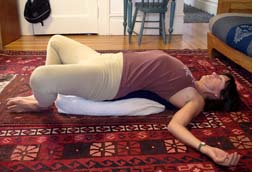 On a yoga mat or area rug, place support that is as long as your torso. Sit in the middle of your support, with your knees bent and your feet on the ground. Place your hands on the floor behind you and slowly lower yourself back onto the support. Most or all of your upper back should be resting on the support. With your feet still on the ground, slowly push your head back over the edge of your support until the back of your head and your shoulders are resting on the ground. The edge of your support should be near the bottom edge of your shoulder blades. Your chest should be elevated. Stretch out your legs and rest your heels on the ground. If this is uncomfortable for your lower back, keep your knees bent and your feet on the ground, or place the soles of the feet together at the groin and support the thighs as in Supta Baddha Konasana.
On a yoga mat or area rug, place support that is as long as your torso. Sit in the middle of your support, with your knees bent and your feet on the ground. Place your hands on the floor behind you and slowly lower yourself back onto the support. Most or all of your upper back should be resting on the support. With your feet still on the ground, slowly push your head back over the edge of your support until the back of your head and your shoulders are resting on the ground. The edge of your support should be near the bottom edge of your shoulder blades. Your chest should be elevated. Stretch out your legs and rest your heels on the ground. If this is uncomfortable for your lower back, keep your knees bent and your feet on the ground, or place the soles of the feet together at the groin and support the thighs as in Supta Baddha Konasana.

As you settle into the pose, actively lift your chest while relaxing your abdominal region down in the direction of the support. If your lower back feels tight, draw your buttocks toward your heels to give your lower back more space, regardless of the position you have chosen for your legs. Rest in the pose for 3 to 5 minutes, so long as you feel comfortable.
To come out of the pose, bend your knees and place your feet on the floor. Place your hands on the support and pull it away from you as you slide over the edge of the support until your lower back and pelvis are on the floor and your legs are up on the support. After a few breaths, draw your knees to your chest and roll to the right-hand side.
Want fruit for your office?
Get your office a free sample TODAY!
3. Viparita Karani(inverted lake or legs-up-the-wall pose)
• Calms the nervous system, rejuvenates the body; alleviates nausea, indigestions, diarrhea, and gas.
Place an area rug or large blanket parallel to a wall and then place support that is as long as your torso. This is an inverted pose and is not recommended for women on their menstrual cycle.
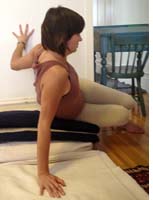 Place your support about 6 inches from the wall on top of a yoga mat or a rug so that the support cannot slide away from the wall. Sit on the edge of the support with your left shoulder touching the wall. Lean away from the wall onto your right palm, and come onto the side of your right hip. Bend your right elbow and roll onto your back while stretching your legs up the wall. Your buttocks should be resting on the wall, and your lower back on the support. There should be no space between the buttocks and the wall. The chest will be opened as your upper body rests over the support. Initially lift the chest and roll the shoulders back and under to emphasize the opening of the chest, then relax completely and allow the abdominal region to settle down toward your support.
Place your support about 6 inches from the wall on top of a yoga mat or a rug so that the support cannot slide away from the wall. Sit on the edge of the support with your left shoulder touching the wall. Lean away from the wall onto your right palm, and come onto the side of your right hip. Bend your right elbow and roll onto your back while stretching your legs up the wall. Your buttocks should be resting on the wall, and your lower back on the support. There should be no space between the buttocks and the wall. The chest will be opened as your upper body rests over the support. Initially lift the chest and roll the shoulders back and under to emphasize the opening of the chest, then relax completely and allow the abdominal region to settle down toward your support.
 If your hamstrings feel too stretched and you are uncomfortable, move your support (and your buttocks) farther away from the wall so that your legs are in less of an acute angle to the wall.
If your hamstrings feel too stretched and you are uncomfortable, move your support (and your buttocks) farther away from the wall so that your legs are in less of an acute angle to the wall.
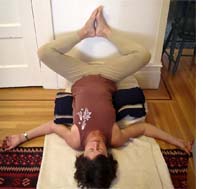 Stay in the pose for 3 to 10 minutes, so long as the pose remains comfortable. At any point, you can place the soles of your feet together as in the Baddha Konasana position, with the buttocks and outer feet supported on the wall.
Stay in the pose for 3 to 10 minutes, so long as the pose remains comfortable. At any point, you can place the soles of your feet together as in the Baddha Konasana position, with the buttocks and outer feet supported on the wall.
To come out of the pose, bend your knees and place your feet on the wall. Place your hands on your support and push yourself away from the wall while pushing the support toward the wall until the buttocks come to rest on the floor.  Rest on your back with your knees bent and feet on the wall, or with straight legs with your heels up on the support. Rest on your back for a few minutes, then draw your knees to your chest and roll to your right-hand side.
Rest on your back with your knees bent and feet on the wall, or with straight legs with your heels up on the support. Rest on your back for a few minutes, then draw your knees to your chest and roll to your right-hand side.
Want fruit for your office?
Get your office a free sample TODAY!
Rebecca Taggart is a San Francisco–based yoga instructor.



